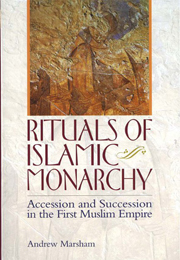Book contents
- Frontmatter
- Contents
- List of maps and figures
- Acknowledgements
- Map 1
- Map 2
- Map 3
- INTRODUCTION
- PART I LATE ANTIQUE ARABIA AND EARLY ISLAM (c. 550–c. 660)
- PART II THE UMAYYAD CALIPHATE (c. 660–750)
- INTRODUCTION
- 4 SUFYANID ACCESSION AND SUCCESSION, c. 660–683
- 5 THE OATH OF ALLEGIANCE IN THE EARLY TRADITION AND POETRY, c. 680–c. 710
- 6 THE MARWANID PATRIMONY AND DYNASTIC SUCCESSION
- 7 MARWANID RITUALS OF ACCESSION AND SUCCESSION
- 8 WRITING AND THE BAYcA IN THE MARWANID PERIOD
- 9 THE QURANIC CONTENT OF THE MARWANID DOCUMENTS
- PART III THE EARLY ABBASID CALIPHATE (c. 750–809)
- PART IV THE MIDDLE ABBASID CALIPHATE (809–865)
- CONCLUSION
- Genealogical table of Quraysh
- Genealogical table of the Abbasid caliphs
- Bibliography
- Index
9 - THE QURANIC CONTENT OF THE MARWANID DOCUMENTS
from PART II - THE UMAYYAD CALIPHATE (c. 660–750)
Published online by Cambridge University Press: 05 September 2013
- Frontmatter
- Contents
- List of maps and figures
- Acknowledgements
- Map 1
- Map 2
- Map 3
- INTRODUCTION
- PART I LATE ANTIQUE ARABIA AND EARLY ISLAM (c. 550–c. 660)
- PART II THE UMAYYAD CALIPHATE (c. 660–750)
- INTRODUCTION
- 4 SUFYANID ACCESSION AND SUCCESSION, c. 660–683
- 5 THE OATH OF ALLEGIANCE IN THE EARLY TRADITION AND POETRY, c. 680–c. 710
- 6 THE MARWANID PATRIMONY AND DYNASTIC SUCCESSION
- 7 MARWANID RITUALS OF ACCESSION AND SUCCESSION
- 8 WRITING AND THE BAYcA IN THE MARWANID PERIOD
- 9 THE QURANIC CONTENT OF THE MARWANID DOCUMENTS
- PART III THE EARLY ABBASID CALIPHATE (c. 750–809)
- PART IV THE MIDDLE ABBASID CALIPHATE (809–865)
- CONCLUSION
- Genealogical table of Quraysh
- Genealogical table of the Abbasid caliphs
- Bibliography
- Index
Summary
The features that the rasāɔil of al-Walīd II and Yazīd III share with mid-eighth-century ‘religious epistles’ give some indication of their function: they are to be read out to large audiences at (in the extant cases) Iraqi and Khurasani mosques. They are also statements of religio-political dogma that begin with the general (even ‘banal’) and move to the particular (and highly contested) for sound rhetorical reasons. Just as the ‘religious epistles’ and sermons of the Kharijites were propaganda, the purpose of the late Marwanid texts is also persuasion – the communication of the caliph's claim to legitimate authority, to the exclusion of all other rival religio-political positions. Thus, the public documents from the late Marwanid bay0a are a partial record of caliphal articulations of their claims to authority (or, at least, the articulations of their scribes and advisers) and hence a partial record of an unequal dialogue between rulers and ruled.
As with the ‘religious epistles’ of their rivals, much of the language with which these texts seek to persuade echoes that of the Qurɔān. As with other Marwanid letters, lengthy quranic quotation is comparatively rare. Nonetheless, the Marwanid texts are replete with quranic allusion and quranic vocabulary. As with the still-growing corpus of seventh- and eighth-century quranic Arabic inscriptions, the content of later copies of documents from the dīwān al-rasāɔil leads to the conclusion that something closely resembling the canonical quranic text was already of great significance to Muslims of the Marwanid era.
- Type
- Chapter
- Information
- Rituals of Islamic MonarchyAccession and Succession in the First Muslim Empire, pp. 168 - 180Publisher: Edinburgh University PressPrint publication year: 2009

